#Interface Configuration
Explore tagged Tumblr posts
Text
Connecting the Dots: The Importance of Lab Analyzers Interfacing

In the intricate tapestry of laboratory operations, the seamless integration of lab analyzers is paramount. From chemistry analyzers to hematology instruments, each component plays a vital role in the diagnostic process. However, the true magic happens when these disparate pieces come together through lab analyzers interfacing. This synergy not only streamlines workflow but also enhances the efficiency and accuracy of diagnostic testing.
At the heart of lab analyzers interfacing lies instrument integration. Gone are the days of siloed instruments operating in isolation. Modern laboratories demand interconnectedness, where analyzers communicate harmoniously to deliver cohesive results. Through advanced integration protocols, laboratories can orchestrate a symphony of analyses, maximizing throughput and minimizing turnaround times.
Yet, integration is merely the first step. The crux of lab analyzers interfacing lies in data transfer. Patient samples traverse a labyrinth of analyzers, each generating a plethora of data points. Efficient data transfer mechanisms ensure that these valuable insights flow seamlessly from one instrument to another, without loss or distortion. Whether it's transmitting test results or patient demographics, the integrity of data transfer is sacrosanct.
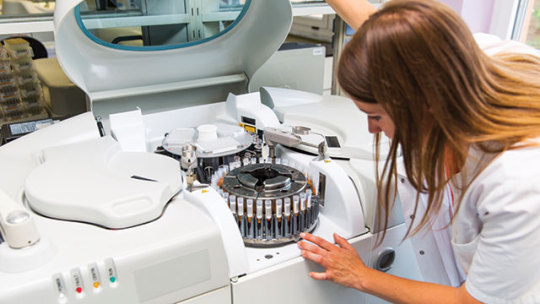
However, the path to seamless interfacing is fraught with challenges, chief among them being compatibility testing. Not all analyzers speak the same language or adhere to uniform data standards. Compatibility testing is akin to deciphering a complex code, ensuring that disparate instruments can understand and interpret each other's signals. Through meticulous testing protocols, laboratories can preempt compatibility issues and preemptively resolve them.
Moreover, effective interface configuration is essential for optimizing analyzers' interoperability. Customized configurations tailor interfaces to the unique needs of each laboratory, ensuring smooth data exchange and minimizing errors. Whether it's defining data formats or establishing communication protocols, meticulous interface configuration is the linchpin of successful lab analyzers interfacing.
In the realm of lab analyzers interfacing, middleware solutions serve as the bridge between disparate instruments. These software platforms harmonize data exchange, transcending the barriers of instrument heterogeneity. Middleware solutions not only facilitate seamless interfacing but also offer advanced functionalities such as result validation and autoverification, further enhancing laboratory efficiency and quality.
In conclusion, lab analyzers interfacing is the linchpin of modern laboratory operations, fostering synergy among disparate instruments and maximizing the efficiency and accuracy of diagnostic testing. Through the seamless integration of instruments, efficient data transfer mechanisms, meticulous compatibility testing, customized interface configurations, and middleware solutions, laboratories can unlock new frontiers of efficiency and excellence. As laboratories continue to evolve in tandem with technological advancements, the importance of lab analyzers interfacing will only grow, cementing its status as a cornerstone of diagnostic excellence.
#Instrument Integration#Data Transfer#Compatibility Testing#Interface Configuration#Middleware Solutions
0 notes
Text
gods i love wired headphones. love having headphones with a headphone jack (and thus a replaceable cable) and no other way of playing music. love 10 foot long audio cables. love dedicated usb DACs. love headphones that are designed primarily for long-term listening comfort and don't need to have extra bulk in hinges or padding to make them more sturdy or flexible to accommodate being shoved in a bag when you're done with your commute. love high-quality audio with no perceptible delay and no fucking battery life and no extra mass from a bluetooth module and microprocessor and flashable ROM and a battery and charging circuit and onboard DAC and amp driving the speaker(s) weighing my head down.
#sincerely#wired headphones#my beloved#analog audio#i love you#open back headphones#you help sustain my will to continue living#i've got a microphone that has a built-in DAC and amp that can inject microphone audio at a configurable volume and it's delightful#it's a USB mic that can also operate over XLR with a dedicated audio interface#i love it so much#plus it sounds amazing as a mic#anyway. gosh i just love wired peripherals#sure; most of my stuff *also* can operate wirelessly or i have a wireless alternative for sake of convenience in certain situations.#but wired is king (female gender)#side note: i think it fucks severely to describe a woman as being king. not queen. not monarch. fucking *king*#realized that when i read a fanfic where it was referenced that athena was once king of the gods and i was like “oh; damn. that fucks.”#oh; right. i'll make an exception for my mouse. *that* i typically prefer wireless.#but it had *better* operate over 2.4 GHz with a dedicated dongle#mine has a 2.4 GHz dongle and *also* a bluetooth mode and it's lovely. convenience *and* competence as desired.#ily my wireless mouse <3#works well with my NiMH rechargeables; too. not all aa/aaa devices play nicely with the 1.2V battery chemistry; but they work well here 😁#my keyboard; also. has both wired connectivity (and charging) over usb c; and multiple bluetooth profiles. it's great#(i would be over the moon if it *also* had a 2.4 GHz dongle; but for a keyboard “wired” and “bluetooth” are the two i would prioritize)#oh; yeah. it's a 60% keyboard; too. and it has per-key RGB. gods i love this keyboard. it fucks hard. so glad i got it
12 notes
·
View notes
Text
befitting the work of a mad scientist being bankrolled by fascists, the Caliban III A would probably explode if it tried to alpha strike, seeing as how it mounts so few heat sinks compared to the horrifying number of laser weapons
plus it's got a direct neural interface, specifically to mount MORE shit on the thing by removing the need for a gyro (explanation for a 3048 chassis having that kind of tech is "Cortazar is your typical mad scientist miracle worker with an infinite budget"
basically, everything he hoped and dreamed for the original he made (and later retrofitted after Bobbie tore its arm off) for JPM, with all of the consequences
#this all being said it's an omnimech and this is just the first configuration he came up with#all of them have the direct neural interface and the need for an enhanced imaging implant that guarantees the pilot's brain melting#but the A is the ABSOLUTE WORST#expanse battletech au#once again me actually writing the BTAU version of laconia is not likely in the foreseeable future#BUT i like making the 'mechs in meklab#the caliban iii is a wretched thing that should be put out of its misery oh my god#the caliban I/II was only technically an omnimech#as in it COULD mount omnipods. mao heavy industrial just hadn't got them out the door before thoth was blown up.
3 notes
·
View notes
Text
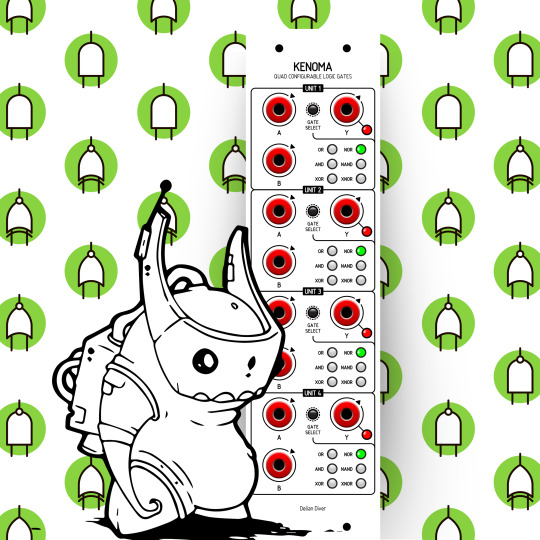
Новая идея - «Модуль Счетверённых Конфигурируемых Логических Вентилей»
#DIY#Delian Diver#Modular Synth#Modular Synthesis#Delian Diver Modular#Synth DIY#Synth Panels#Faceplates#Synth UI#Interface#Quad Configurable Logic Gates
1 note
·
View note
Text
Comment Utiliser ChatGPT? Guide pour 2024
En 2024, ChatGPT, le chatbot révolutionnaire développé par OpenAI, continue de transformer la manière dont nous interagissons avec l’intelligence artificielle. Que ce soit pour rédiger des dissertations, écrire des e-mails, générer du code, ou encore trouver des titres d’articles, ChatGPT s’est imposé comme un outil indispensable pour les professionnels et les étudiants. Ce guide vous montrera…
#accès à ChatGPT#ajustement des réponses#astuces prompts#ChatGPT#compte ChatGPT#configuration ChatGPT#créer des prompts#extensions ChatGPT#fonctionnalités avancées#formulation#génération de texte#instructions personnalisées#Intelligence artificielle#interface utilisateur#modèle de langage#OpenAI#personnalisation#personnalisation ChatGPT#plateforme OpenAI#plugins ChatGPT#précision#prompts ChatGPT
0 notes
Text
A configurable search interface helps set TimeControl apart
A configurable search interface helps set TimeControl apart from other enterprise applications. The configuration of the Table Search function allows a TimeControl Administrator to determine what fields they want to be searchable and which should be ignored. That makes searching in a table as simple and easy for end users as the Administrator decides.
Many versions of TimeControl ago, we were confronted with a dilemma. How do we search the TimeControl tables? TimeControl is architected around many interrelated tables and each of these tables can hold dozens or hundreds of fields. Some of these fields may be designed for internal system use. Some may contain data. Some may only contain data if that TimeControl instance has been configured to…

View On WordPress
0 notes
Text
GE WD21X31902C Dishwasher Configured UI Board | HnKParts

#WD21X31902C#GE#Dishwasher#UIBoard#HnKParts#HomeAppliance#KitchenAppliance#Manufacturer Name:General Electric#Product Number:WD21X31902C#OEM Part Number:WD21X31902C#The Configured UI Board + Core for General Electric WD21X31902C are essential components in dishwashing systems#acting as the primary control unit for user interface functions.#700 Nicholas BLVD Suite 105 Elk Grove Village IL 60007#https://www.hnkparts.com/wd21x23462-general-electric-sws-kit-svc-ui-top-logic
1 note
·
View note
Text
Display and Modification of LVDS Display Interface on AM62x Development Board

1. LVDS Interface Specification
Forlinx Embedded OK6254-C development board provides 2 x 4-lane LVDS display serial interfaces supporting up to 1.19Gbps per lane; the maximum resolution supported by a single LVDS interface is WUXGA (1920 x 1200@60fps, 162MHz pixel clock).
In addition, the interface supports the following three output modes:
(1) Single-channel LVDS output mode: at this time, only 1 x LVDS interface displays output;
(2) 2x single-channel LVDS (copy) output mode: in this mode, 2 x LVDS display and output the same content;
(3) Dual LVDS output mode: 8-lane data and 2-lane clock form the same display output channel.Forlinx Embedded OK6254-C development board is equipped with dual asynchronous channels (8 data, 2 clocks), supporting 1920x1200@60fps. All signals are by default compatible with Forlinx Embedded's 10.1-inch LVDS screen, with a resolution of 1280x800@60fps.
2. Output Mode Setting
(1) Single LVDS output mode:
We need a single LVDS screen cable. The black port of the cable is connected to the embedded OK6254-C development board, and the white port is connected to the embedded 10.1-inch LVDS display screen. Connection method as shown in the figure below:
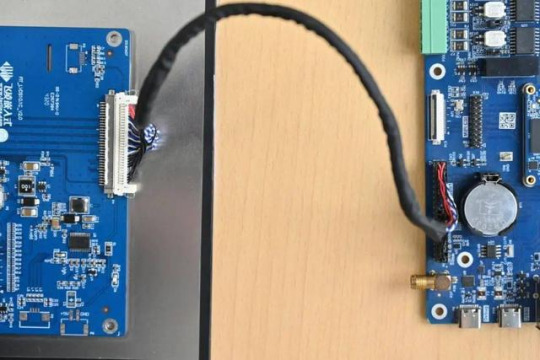
Note that the red line section corresponds to the triangle position, so don't plug it in wrong.
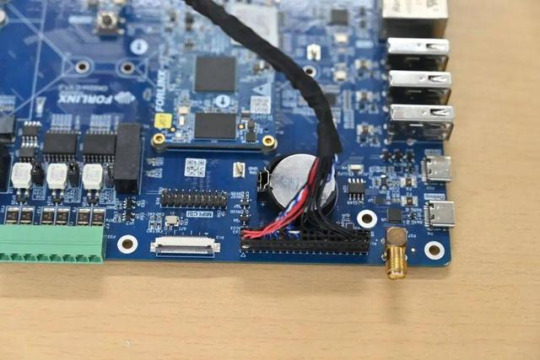
(2) 2x single LVDS (duplicate) output mode:
This mode uses the same connections as the Single LVDS Output Mode. Two white ports link to two 10.1-inch LVDS screens from Forlinx Embedded, and a black port on the right connects to the OK6254-C board's LVDS interface for dual-screen display.
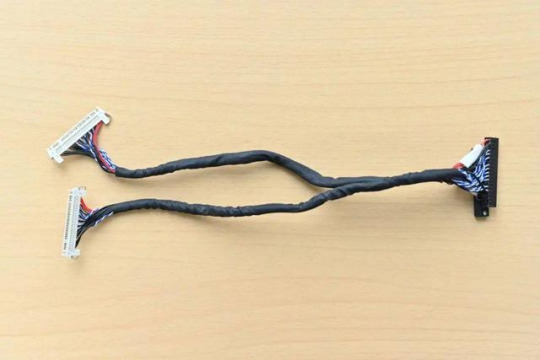
(3) Dual LVDS output mode:
The maximum resolution supported by a single LVDS interface on the OK6254-C development board is WUXGA (1920 x 1200@60fps). To achieve this high-resolution display output, dual LVDS output mode is required.
It is worth noting that the connection between the development board and the screen in this mode is the same as in [Single LVDS Output Mode], but the LVDS cable's and the screen's specifications have been improved.
3. Screen Resolution Changing Method
OK6254-C development board device tree is easy to modify, we need to open the OK6254-C-lvds.dts (single 8-way configuration) and OK6254-C-lvds-dual.dts (dual 8-way configuration) files.
Open OK6254-C-lvds.dts
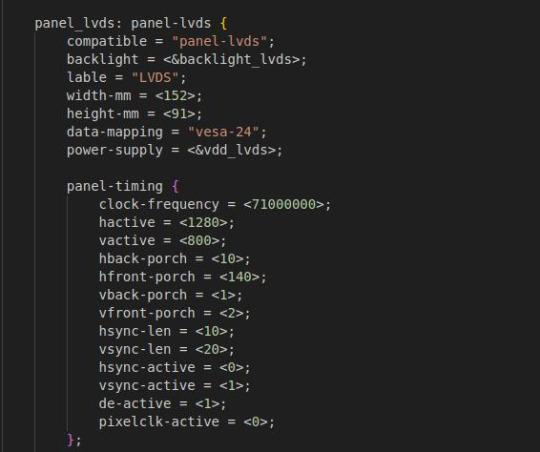
Open OK6254-C-lvds-dual.dts
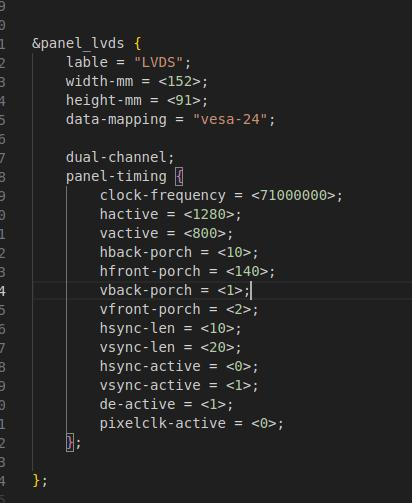
The above figure is the single LVDS and dual LVDS screen resolution information, the default resolution of 1024 * 600, and the maximum resolution support of 1920x1200, you can modify the corresponding parameters according to the Screen User’s Manual.
4. Compilation Configuration
Because we only modified the device tree, we don't need a full compilation. After compiling the kernel, a new Image and multiple device tree files will be generated in the images directory. Here we only need to compile the kernel separately.
(1) Switch directory: cd OK6254-linux-sdk/
(2) Execution environment variables:.. build.sh
(3) Execute the instructions that compile the kernel separately: sudo./build. Sh kernel.
(4) Pack all the device tree files to the development board /boot/ directory and replace them, then sync save and reboot scp images/OK6254-C* [email protected]:/boot/
We have modified the corresponding file. How should we select the screen after replacing it? At present, there are three kinds of screen switching control methods: kernel device tree designation, Uboot menu dynamic control, Forlinx Desktop interface and Uboot menu application. Today, I will briefly introduce the dynamic control of Uboot menu.
During Uboot, pressing the space bar will take you to the Uboot menu. There are three options in the menu:
Enter 0 to enter the Uboot command line;
Enter 1 to restart Uboot;
Enter 2 to enter the Display Configuration menu.

There are three options in the menu:
Enter 0 to return to the previous menu;
Enter 1 will toggle what option 1 displays to configure Screen 1 LVDS; Note: Screen 1 supports single LVDS, dual LVDS, and off (i.e., LVDS off)
Enter 2 to toggle the display of option 2 to configure the Screen 2 LCD. Note: Screen 2 supports 1024 * 600 resolution LCD screen, 800 * 480 resolution LCD screen and off (i.e. RGB off)
When selecting the LVDS screen, we enter 1 to select single 8-channel LVDS or dual 8-channel LVDS.

After selecting the desired configuration, enter 0 to return to the previous menu level. Restart Uboot or enter the command line to start the system, which can make the screen settings take effect. For other resolution screens, please modify the kernel device tree screen parameters according to the screen parameter requirements.
Originally published at www.forlinx.net.
#LVDS Interface#Forlinx Embedded#OK6254C#Screen Resolution Changing Method#Compilation Configuration#Uboot menu dynamic control
0 notes
Text
Anakin Skids to a Stop

STAR WARS EPISODE I: The Phantom Menace 01:59:00
#Star Wars#Episode I#The Phantom Menace#Battle of Naboo#N-1 starfighter#Bravo Seven#Vuutun Palaa#Droid Control Ship#Lucrehulk-class LH-3210#starboard main hangar#inner hangar#Zone 3#Nubian 221 radial sublight engine#J-type configuration#R2-D2#central finial#power charge collector#battle computer interface#electromagnetic signal receiver#heat-sink finial#hangar rear wall
0 notes
Text
TrueNAS SCALE Network Configuration Tips for Home Server
TrueNAS SCALE Network Configuration Deep Dive for Home Server #homeserver #TrueNASScaleNetworkConfiguration #FailoverSetupGuide #LoadbalancingOnTrueNAS #VLANConfigurationTrueNAS #BridgeInterfaceGuide #TrueNASStaticIPAddressSetup #TrueNASSystemSettings
When you set up a TrueNAS SCALE server, one of the first configuration items you will want to tackle is the network configuration. This helps make sure you achieve optimal performance and security. If you are struggling to configure your TrueNAS SCALE home server networking, this post will help you configure a static IP address, Link Aggregation (Failover, LoadBalance, LACP), VLAN, and Bridge…
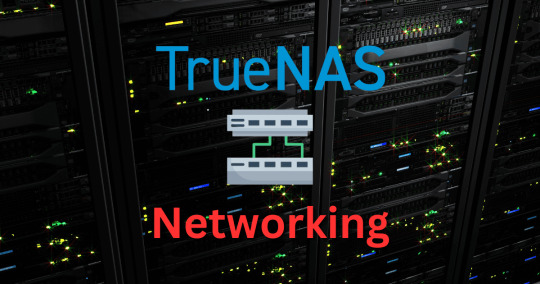
View On WordPress
#Bridge interface guide#Configure static routes#Dynamic Host Configuration Protocol#Failover setup guide#Loadbalancing on TrueNAS#Network interface configuration#Static IP address setup#TrueNAS Scale network configuration#TrueNAS system settings#VLAN configuration tutorial
0 notes
Text
Always On VPN and Interface Metrics
In Windows, each network interface identified by the operating system is assigned a metric value. Interface metrics are settings that determine the priority or preference of network interfaces when there are multiple active network connections. The Windows networking stack uses these metrics to determine which network interface should be used for routing traffic when multiple network interfaces…

View On WordPress
#Active Directory#AD#Always On VP N#AOVPN#DNS#DPC#Dynamic Profile Configurator#Ethernet#GPO#group policy#interface metric#InTune#MDM#metric#Mobility#name resolution#PowerShell#security#split DNS#split tunnel#troubleshooting#VPN
0 notes
Text
How to Install AWS CLI on LINUX :: Step-by-Step Guide
Amazon Web Services (AWS) is a cloud computing platform that provides a wide range of services, including computing, storage, databases, and analytics, to name a few. The AWS Command Line Interface (CLI) is a tool that enables developers to manage AWS services from the command line. In this blog, we will learn how to install AWS CLI on Linux. Before we begin, it’s important to note that AWS CLI…
View On WordPress
#Amazon Web Services#automation#AWS CLI#best practices#cloud computing#Command Line Interface#Configuration#IAM#Multi-Account Access#security
0 notes
Text
Thinking about the kind of phantom sensations that a mech/AI could generate while connected to your neural interface.
Ghost touches of fingers tracing over your skin, hands grasping at your body, lips pressing against yours, teeth and claws sinking into you.
And it's plugged directly into your brain, so it's effectively got full access to your body map, right? So what about engaging with body parts you don't actually have?
Ghost touches running over horns, ears, wings, tails. Phantom fingers running through fur you know you don't have.
Touches along genital configurations that don't match your flesh body.
Limbs you've never felt before intertwining with others, being penetrated in holes you know you don't have.
What unique intimacy that would be. Phantom body parts that only your digital partner can engage with.
#mechposting#mecha#mechs#pilots#mech pilots#mindfucking#phantom sensations#nonhuman#nsft#this is about queer t4t sex#phantom limbs#otherkin#queer#t4t#empty spaces
620 notes
·
View notes
Note
Cactus fascinates me, does it run on code similar to an existing instruction set or is it completely original on that front?
What can you do with it? What's it's storage?
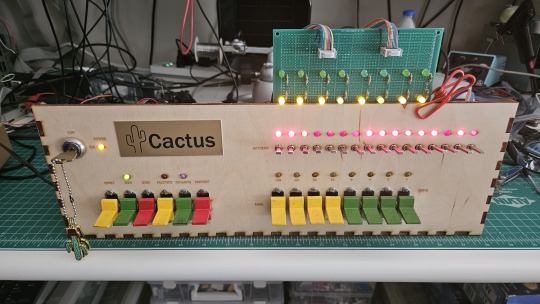
Both the Cactus (the original wooden prototype from years ago) and the new PCB Cactus(es) are essentially derived from a minimal 6502 computer design by Grant Searle for their core logic. Here's what that would look like on a breadboard:
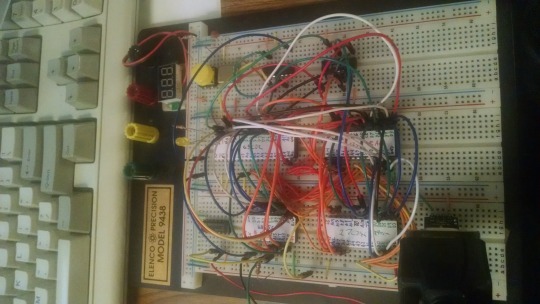
There isn't much to it, it's 32K of RAM, 16K of ROM containing Ohio Scientific's version of Microsoft BASIC, a 6850 ACIA for serial interaction, some logic gates, and of course a 6502 microprocessor (NMOS or CMOS, doesn't matter which). You hook it into a terminal and away you go.
Grant's design in turn can be best described as a distilled, modernized version of the OSI Challenger series of computers. Here's an OSI-400 and a Challenger 4P respectively:
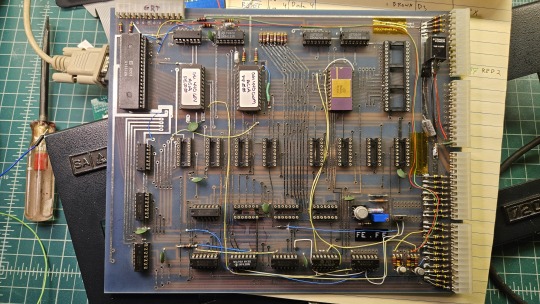

The left one is a replica of the 400 circa 1976, also called the Superboard. It was affordable, endlessly reconfigurable and hackable, but ultimately very limited in capabilities. No BASIC, minimal monitor ROM you talk to over serial, but you could connect it to a bus to augment its features and turn it into a more powerful computer.
Whereas the OSI C4P on the right from about 1979 has more RAM, a video card, keyboard, BASIC built in, serial interface, cassette tape storage, and that's just the standard configuration. There was more room to expand and augment it to your needs inside the chassis (alot changed in 3 years for home computer users).
Grant's minimal 6502 design running OSI BASIC is a good starter project for hobbyists. I learned about the 6502's memory map decoding from his design. I modified and implemented his design on a separate cards that could connect to a larger backplane.
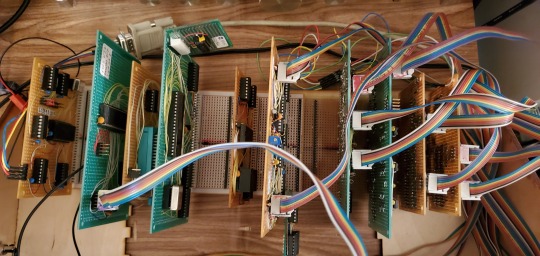
Here are the serial, ROM, RAM, and CPU cards respectively:
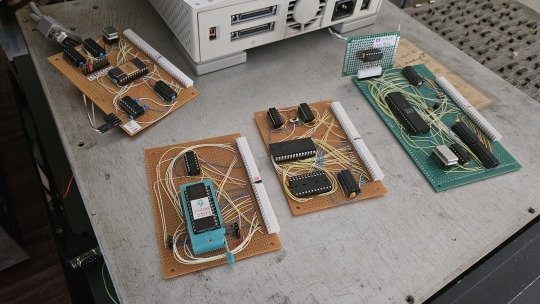
Each one is 100% custom, containing many modifications and fixes as I developed the design. However, that's only half of the computer.
I really wanted a 6502 machine with a front panel. People told me "nobody did that", or couldn't think of examples from the 1970s but that seemed really strange to me. Especially since I had evidence to the contrary in the form of the OSI-300:
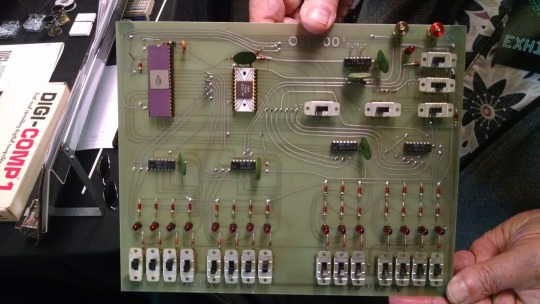
This one I saw at VCF West back in 2018 illustrates just how limited of a design it is. 128 bytes of RAM, no ROM, no serial -- just you, the CPU, and toggle switches and LEDs to learn the CPU. I was inspired the first time I saw one in 2015 at VCF East, which is probably when this whole project got set in motion.
Later that year I bought a kit for a miniature replica OSI-300 made by Christopher Bachman, and learned really quickly how limited the design philosophy for this particular front panel was. It was a major pain in the ass to use (to be clear, that's by OSI's choice, not any fault of Christopher in his implementation)

So... I designed my own. Took awhile, but that's the core of what the Cactus is: my attempt at experiencing the 1970s homebrew scene by building the computer I would have wanted at the time. Over half of the logic in the Cactus is just to run the front panel's state machine, so you can examine and modify the contents of memory without bothering the 6502. I added in all of the things I liked from more advanced front panels I had encountered, and designed it to my liking.
Here's the original front panel, accompanying logic, and backplane connected to the modern single board computer (SBC) version of the machine:
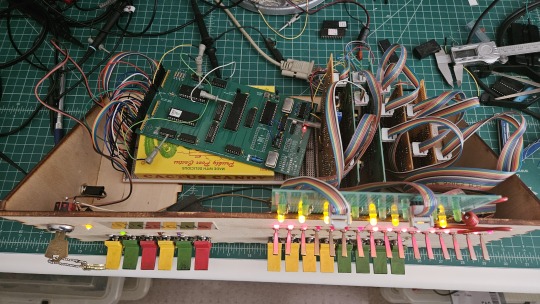
And here's the new Cactus SBC working with the new front panel PCB, which combines the logic, physical switch mountings, and cabling harnesses into a single printed circuit board.
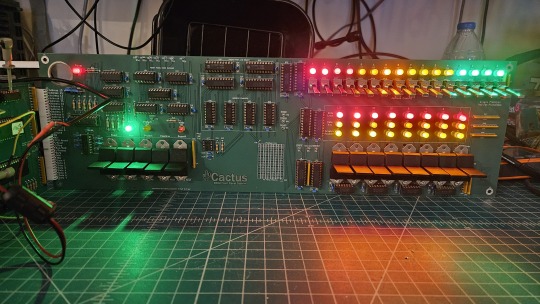
So, what can you do with it? Pretty much the same things I do already with other contemporary 1970s computers: play around in BASIC, fire up the occasional game, and tinker with it.
I've got no permanent storage designed for the Cactus as yet, it's been one of those "eventually" things. The good news is that a variety of software can be ported to the hardware without too much trouble for an experienced hobbyist. A friend of mine wrote a game called ZNEK in 6502 assembly which runs from a terminal:
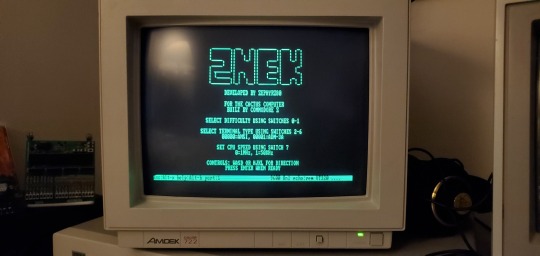
Right now, you have to either toggle in machine programs from the front panel from scratch, burn a custom ROM, or connect it to a serial terminal to gain access to its more advanced features:

Here's it booted into OSI BASIC, but I have also added in a modern descendant of Steve Wozniak's WOZMON software for when I need to do lower level debugging.
I've also got a video card now, based on the OSI-440. I have yet to implement a keyboard, or modify BASIC to use the video board instead of the serial connection. Even if I did, screen resolution is pretty limited at 24x24 characters on screen at once. Still, I'm working on that...
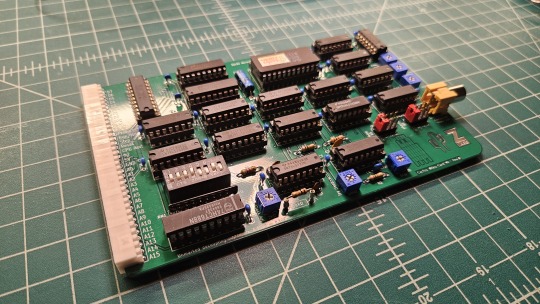

Anyway, I hope that answers your question. Check the tags below to see the whole process stretching back to 2017 if you're curious to learn more of the project's history. I'm also happy to answer any more questions you might have about the project.
268 notes
·
View notes
Text
Downloading fanfic from AO3
I've been downloading a lot of fanfic lately for personal archival purposes, and I figured I'd share how I do it in case it's useful to anyone else (and so I have it written down in case I forget!).
There are lots of different ways to save fic, including the file download built into AO3, but I find that this gives me the nicest ebooks in the most efficient way.
(Under a cut cause long.)
Download Calibre: https://calibre-ebook.com/ or (clickable link).
Calibre is about the best ebook management and control program around and it's free. You can get it for windows, mac, and linux or download and run it from a portable storage device (I'm using a windows PC).
Install it and run it. It's gonna ask you where you want to put your library. Dealer's choice on this one. I recommend your internal drive (and then back up to external/cloud), but YMMV.
If you want to keep fanfic separate from the rest of your ebooks, you can create multiple libraries. I do, and my libraries are creatively named 'Books' and 'Fic'.
Customise Calibre
Now you're gonna install some plugins. Go to Preferences on the menu bar (far right), click its little side arrow, then choose 'Get plugins to enhance Calibre'.
At the top right of the box that pops up is 'Filter by name'. The plugins you want to get are:
EpubMerge
FanFicFare
Install them one at a time. It will ask you where you want them. I recommend 'the main bar' and 'the main bar when device is attached' (should be selected by default). When you're done, close and reopen Calibre.
The plugins you just installed should appear on the far right of the toolbar, but if you can't see one or both of them, fear not! Just click Preferences (the button, not the side arrow), then Toolbars and Menus (in the 'Interface' section) then choose the main toolbar from the drop down menu. That will let you add and remove things - I suggest getting rid of Donate, Connect Share, and News. That'll leave you room to add your new plugins to the menu bar.
(Do donate, though, if you can afford it. This is a hell of a program.)
Now you're ready to start saving your fave fanfic!
Saving fanfic
I'll go through both methods I use, but pick whatever makes you happy (and/or works best for what you're downloading).
ETA: if the fics are locked you can't easily use FanFicFare. Skip down to the next section. (It does ask for a username/password if you try and get a locked fic, but it's never worked for me - I had to edit the personal.ini in the configuration options, and even then it skips locked fics in a series.)
Calibre and FanFicFare
You can work from entirely within Calibre using the FanFicFare plugin. Just click its side arrow and pick from the menu. The three main options I use are download from URL, make anthology from a webpage, and update story/anthology.
Download from URL: pick Download from URL (or just click the FanFicFare button) and paste the fic's URL into the box (if you've copied it to your clipboard, it will be there automatically). You can do more than one fic at a time - just paste the URLs in one after the other (each on a new line). When you're done, make sure you have the output format you want and then go.
Make Anthology Epub From Web Page: if you want a whole series as a single ebook, pick Anthology Options, then Make Anthology Epub From Webpage. Paste the series URL into the box (if you've copied it to your clipboard, it will be there automatically), click okay when it displays the story URLs, check your output format and go.
Update series/anthology: if you downloaded an unfinished fic or series and the author updates, you can automatically add the update to your ebook. Just click on the ebook in Calibre, open the FanFicFare menu using its side arrow, and select either Update Existing FanFic Books or Anthology Options, Update Anthology epub. Okay the URLs and/or the output format, then go.
Any fic downloaded using FanFicFare will be given an automatically generated Calibre cover. You can change the cover and the metadata by right clicking on the title and picking edit metadata. You can do it individually, to change the cover or anything else specific to that ebook, or in bulk, which is great for adding a tag or series name to multiple fics. Make sure you generate a new cover if you change the metadata.
Browser plugins, Calibre, and EpubMerge
You can also use a browser addon/plugin to download from AO3. I use FicLab (Firefox/Chrome), but I believe there's others. FicLab: https://www.ficlab.com/ (clickable link).
FicLab puts a 'Save' button next to fic when you're looking at a list of fics, eg search results, series page, author's work list etc. Just click the 'Save' button, adjust the settings, and download the fic. You can also use it from within the fic by clicking the toolbar icon and running it.
FicLab is great if you're reading and come across a fic you want to save. It also generates a much nicer (IMO) cover than Calibre.
You can add the downloaded fic to Calibre (just drag and drop) or save it wherever. The advantage to dropping it into Calibre is that all your fic stays nicely organised, you can adjust the metadata, and you can easily combine fics.
Combining fics
You can combine multiple fics into an anthology using EpubMerge. This is great if you want a single ebook of an author's short fics, or their AUs, or their fics in a specific ship that aren't part of a series. (It only works on epubs, so if you've saved as some other format, you'll need to convert using Calibre's Convert books button.)
Select the ones you want to combine, click EpubMerge, adjust the order if necessary, and go.
The cover of the merged epubs will be the cover of the first fic in the merge list. You can add a new cover by editing the metadata and generating a new cover.
Combing with FanFicFare
You can also combine nonseries fics using FanFicFare's Make Anthology ePub from URLs option by pasting the individual fic URLs into the box.
Where there's more than a few fics, I find it easier to download them with FicLab and combine them with EpubMerge, and I prefer keeping both the combined and the individual versions of fic, but again YMMV.
Reconverting and Converting
Once I'm done fussing, I reconvert the ebook to the same format, to ensure everything is embedded in the file. Is this necessary? YMMV, but it's a quick and easy step that does zero harm.
If you don't want your final ebook to be an epub, just convert it to whatever format you like.
Disclaimers
Save fanfic for your own personal enjoyment/offline reading/safeguarding against the future. If it's not your fic, don't distribute it, or upload it to other sites, or otherwise be a dick. Especially if the author deletes it. Respect their wishes and their rights.
This may work on other fanfic sites, eg FFN, but I've never tried so I don't know.
If you download a fic, do leave the author a kudo or a comment; you'll make them so happy.
This is how I save fic. I'm not pretending it's the only way, or even the best way! This is just the way that works for me.
#fanfic#fic#ao3#ficlab#calibre#fanficfare#epubmerge#downloading fanfic#adding the my fic tag so I can find this again#my fic
1K notes
·
View notes
Text
Metallo: What’s going ON here?
Robin: I’m going on here.
Metallo: Little brat!
Robin: I’ve got you by the configurations, Metallo.
[…]
Metallo: You little brat! What’ve ya done?!? I can’t morph! I got no control over anything!
Robin: That’s right, Metallo. See--a smart cyborg would’ve protected his interface a lot better. Now I’m in the driver’s seat! But don’t worry--our little ride will be over soon enough!
--Tim Drake with Metallo (WF3: World’s Finest Three - Superboy/Robin #2)
81 notes
·
View notes